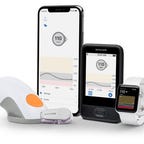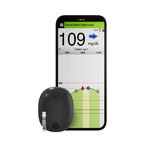
Best continuous glucose monitor for pairing with phones or Apple Watch
Dexcom G6
View details
If you’re diabetic, monitoring blood glucose levels is probably a necessary part of your daily life. But the traditional method of pricking your finger to check your blood glucose levels can get frustrating. Thankfully, there are continuous glucose monitors, or CGMs in the market that are designed to be worn and used over long periods and work as a better alternative to keep track of your glucose levels. These devices can potentially be worn on the belly or the arm and may help you make decisions throughout the day based on your blood glucose readings, which can help with managing diabetes.
We consulted doctors and researched the most popular models to curate the best continuous glucose monitors on the market. Just be sure to talk to your doctor about diabetes monitor options to make a plan for the best health monitoring for you.
Best continuous glucose monitors of 2024
This meter is recommended by Dr. Rebecca Fenichel, an endocrinologist at Westmed Medical Group, and was previously recommended by Dr. Nate Favini, medical lead of Forward. “For people who are interested in deeper insights into their glucose levels, I’ll often recommend the Freestyle Libre for continuous glucose monitoring,” Favini said. (Note from Jan. 25, 2024: Since this list was first published, the Freestyle Libre 3 has launched. This sensor is smaller than the Libre 2 and has readings sent directly to your smartphone every minute, along with other perks.)
“By placing a sensor on your arm, you can track your glucose constantly through the day and develop your understanding of what makes your sugar levels go up and down,” he said. “People will often be surprised that foods that they assumed were good for their glucose levels may be causing spikes in their sugar. Though continuous glucose monitors are more expensive, they can help you understand what types of food and exercise are best for you.”
To read your blood sugar on the Freestyle Libre, you do a quick scan with the CGM device to get a reading. There are also optional alarms if your blood sugar gets too high or too low.
“I find continuous glucose monitoring to be a valuable tool in the management of both type 1 and 2 diabetes,” said Dr. Josh Emdur, medical director of SteadyMD. “CGM data provides actionable insight to help patients track their glycemic response to dietary choices and activity levels.”
The Dexcom G6 doesn’t require you to manually scan to get a glucose level reading. Instead, you get a wireless reading either on a dedicated receiver device or to your phone or Apple Watch. The Dexcom G6 reads your blood sugar every 5 minutes, keeping track of your blood sugar level as long as you’re wearing it night and day. You can set a custom range for where you’d like your blood sugar to be, and if it goes into low blood sugar or high blood sugar ranges you set, you will get notified.
“For patients on an insulin pump, the Dexcom G6 may connect with your pump and offer a closed-loop system to turn off your insulin if you are going low. The Dexcom monitor is also approved in pregnancy and offers continuous monitoring that you can see on your phone at all times,” Fenichel said. (Note, Jan. 25, 2024: Since this article was first published, Dexcom has launched the G7. This sensor is smaller than the G6 and has an improved alert system, along with a few other differences.)
If you want a device that you can set up and don’t have to worry about reinserting for up to 180 days, Eversense is a great option for diabetes management. A healthcare provider will insert the sensor, and then you place the transmitter above that.
Once the sensor is in place, you don’t have to change it out for about 180 days, a long sensor life. The transmitter itself can alert you if your blood sugar is too high or low, and you can also have wireless readings sent to your phone via an app. You can share your blood glucose data from your app with your doctor or anyone else who wants to check your blood sugar readings.
The Guardian Connect System is a CGM that can tell you your current glucose readings quickly via a connected app and also lets you easily access trends and data about your blood sugar over time. One feature that stands out with The Guardian is the “predictive” alerts you can get about your sugar. Unlike other CGM systems that alert you when your sugar is already high or low, The Guardian uses technology that predicts when your blood sugar might get high or low before it happens. Another feature that comes with the monitor is the Sugar.IQ diabetes assistant app for diabetes management, which uses your data to help you figure out what diet, exercise and insulin works best for you.
When choosing continuous glucose monitors for this list, we look at which models were previously recommended by doctors. We also look to include a CGM that has a longer-lasting sensor life and include models that are popular choices for people with diabetes.
“Continuous glucose monitors offer more intensive monitoring of a diabetic patient’s sugar levels,” Fenichel said. “They are particularly well suited to patients who have to check multiple times a day or to patients who want to get more frequent feedback during the day.”
While anyone can buy a regular blood glucose meter, you’ll need a prescription from your doctor for a CGM system. Doctors may recommend a continuous blood glucose monitoring device for reasons tied to your unique health circumstances and lifestyle, to track your glucose trends and keep on top of your insulin levels, but a CGM device may not work for everyone’s unique diabetes care plan.
CGM devices can also give you and your doctor more information about blood sugar levels than a standard meter — like if your blood sugar begins to drop too low, the device can warn you about your dropping blood glucose levels, “which can be a very helpful feature in helping patients avoid hypoglycemia,” Fenichel said. “They can tell you not only what your current sugar level is but also whether it is on the way up or on the way down.”
Here are some factors to consider when shopping for continuous glucose monitors:
- Scan frequency: Real-time CGMs continuously scan your glucose levels and automatically transmit the data to your phone or receiver, sending regular alerts about your blood sugar. By contrast, with intermittent-scan CGMs, you have to scan them with your phone or receiver to see the data. Some CGMs also measure your glucose more frequently than others.
- Connectivity: Consider whether you want to connect the CGM to your smartphone or to a receiver. If you’re using a phone, look closely at the app and whether it’s easy to use or offers special features.
- Test type: Consider where on your body the CGM’s sensor will be placed, how it’s inserted, and how often it will have to be replaced.
- Insurance coverage: Check whether the CGMs you’re interested in are covered by your insurance, and how much the parts will cost to maintain and replace over time.
Can I get a continuous glucose monitor without a doctor?
Is continuous glucose monitoring covered by insurance?
Which CGM is the cheapest?
The information contained in this article is for educational and informational purposes only and is not intended as health or medical advice. Always consult a physician or other qualified health provider regarding any questions you may have about a medical condition or health objectives.

























+ There are no comments
Add yours